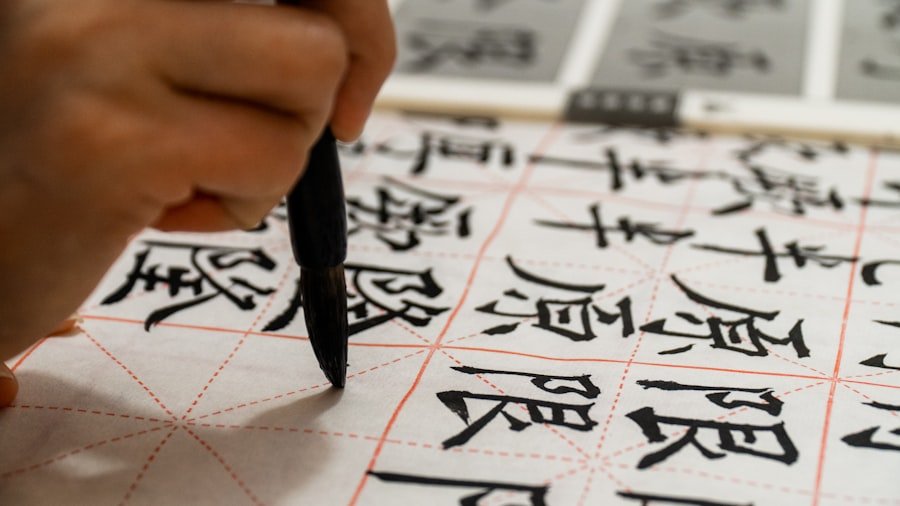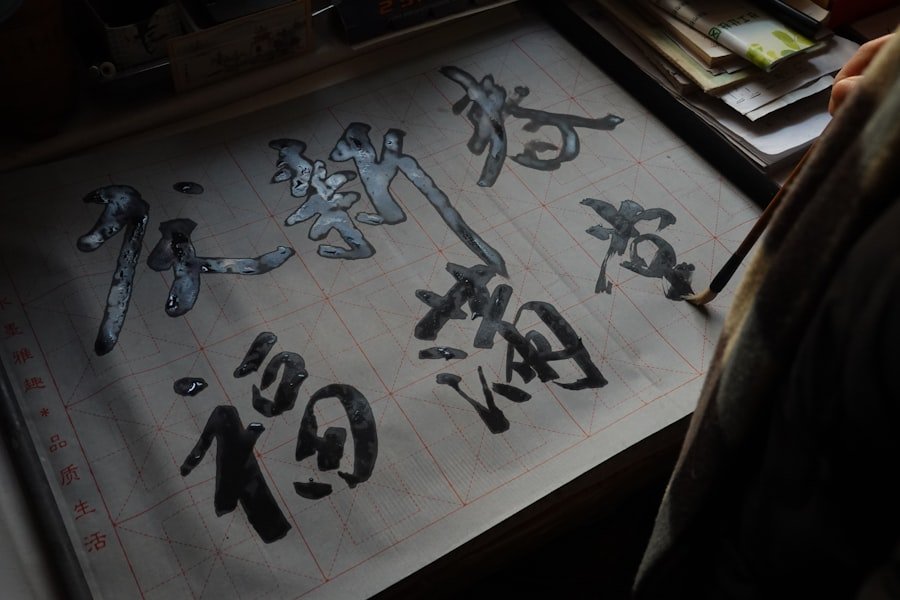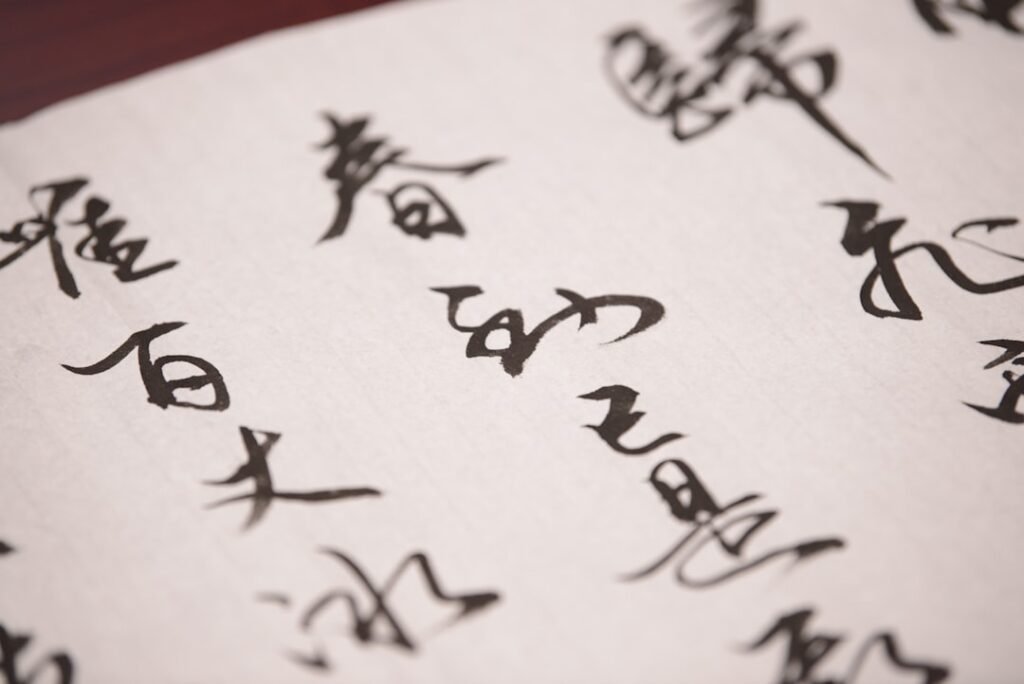Chinese calligraphy, an art form that has flourished for thousands of years, is not merely a means of communication but a profound expression of culture and philosophy. Its origins can be traced back to the Shang Dynasty (1600-1046 BC), where inscriptions on oracle bones marked the beginning of written Chinese. Over the centuries, calligraphy evolved into a highly regarded art form, with various styles emerging, such as Seal Script, Clerical Script, and Regular Script.
Each style reflects the historical context and aesthetic preferences of its time, showcasing the dynamic nature of Chinese culture. The significance of calligraphy extends beyond its aesthetic appeal; it embodies the philosophical underpinnings of Confucianism, Daoism, and Buddhism. Calligraphy is often seen as a reflection of the calligrapher’s character and emotions, with each stroke representing a moment of mindfulness and intention.
This deep connection between the artist and their work has made calligraphy a revered practice in Chinese society, often associated with scholarly pursuits and moral integrity. As such, it has played a crucial role in shaping Chinese identity and cultural heritage throughout history. Master the art of Chinese calligraphy. Enroll now at the LC Chinese School in Oslo.
Table of Contents
ToggleSummary
- Chinese calligraphy has a rich historical significance, dating back thousands of years and playing a crucial role in Chinese culture and art.
- The impact of digital technology on traditional calligraphy has led to both challenges and opportunities, with the digital age influencing the way calligraphy is created and shared.
- Preserving Chinese calligraphy in a digital age presents challenges such as the risk of losing traditional techniques and the need for innovative preservation strategies.
- Traditional calligraphy continues to play a significant role in contemporary Chinese society, with its cultural and artistic value remaining relevant.
- The evolution of calligraphy tools and techniques in the digital age has led to the intersection of calligraphy and digital art, creating new possibilities for artistic expression.
The Impact of Digital Technology on Traditional Calligraphy
The advent of digital technology has brought about significant changes in various art forms, and Chinese calligraphy is no exception. With the rise of computers and smartphones, traditional methods of writing have been supplemented by digital tools that allow for greater convenience and accessibility. Digital calligraphy software enables artists to create intricate designs with ease, offering a new platform for expression that was previously unimaginable.
This shift has opened up opportunities for younger generations to engage with calligraphy in ways that align with their digital lifestyles. However, while digital technology has made calligraphy more accessible, it has also raised questions about authenticity and the preservation of traditional techniques. The tactile experience of ink on paper, the careful control of brush strokes, and the meditative process of creating calligraphy are aspects that cannot be fully replicated in a digital environment.
As artists navigate this new landscape, they must find a balance between embracing technological advancements and honouring the rich traditions that define Chinese calligraphy.
The Challenges of Preserving Chinese Calligraphy in a Digital Age

As digital technology continues to permeate every aspect of life, the preservation of traditional Chinese calligraphy faces numerous challenges. One significant concern is the potential loss of skills associated with traditional brushwork. With the convenience of digital tools, fewer individuals are taking the time to learn the intricate techniques required for mastering calligraphy.
This decline in practice threatens to diminish the cultural significance of this art form, as fewer practitioners are able to pass down their knowledge to future generations. Moreover, the rapid pace of technological advancement can lead to a disconnect between traditional practices and contemporary expressions. As younger artists gravitate towards digital mediums, there is a risk that the essence of calligraphy may become diluted or misrepresented.
The challenge lies in finding ways to integrate traditional techniques with modern technology while maintaining the integrity and depth of this ancient art form. It is essential for educators and practitioners to advocate for the importance of preserving traditional skills even as they explore new avenues for expression.
The Role of Traditional Calligraphy in Contemporary Chinese Society
In contemporary Chinese society, traditional calligraphy continues to hold a significant place despite the encroachment of modernity. It serves as a bridge between past and present, connecting individuals to their cultural roots while also allowing for personal expression. Calligraphy is often featured in public spaces, such as galleries and exhibitions, where it is celebrated not only as an art form but also as a means of fostering community and cultural pride.
Furthermore, calligraphy plays an essential role in education and personal development. Many schools incorporate calligraphy into their curricula as a way to instil discipline, patience, and an appreciation for cultural heritage among students. The practice encourages mindfulness and focus, qualities that are increasingly valuable in today’s fast-paced world.
As such, traditional calligraphy remains relevant, providing individuals with a sense of identity and continuity amidst rapid societal changes.
The Evolution of Calligraphy Tools and Techniques in the Digital Age
The tools and techniques used in calligraphy have evolved significantly over time, particularly with the introduction of digital technology. Traditional brushes made from animal hair and handmade paper have been complemented by digital tablets and styluses that allow artists to create with precision and ease. Software programs designed specifically for calligraphy offer a range of features that enable users to experiment with different styles and effects, expanding the possibilities for artistic expression.
Despite these advancements, many artists continue to value traditional tools for their unique qualities. The feel of a brush gliding across paper, the sound of ink being mixed, and the visual impact of each stroke contribute to the overall experience of creating calligraphy. As artists navigate this duality between traditional and digital tools, they often find inspiration in blending both approaches, resulting in innovative works that honour the past while embracing the future.
The Intersection of Calligraphy and Digital Art

The intersection of calligraphy and digital art has given rise to exciting new possibilities for creative expression. Artists are increasingly experimenting with combining traditional calligraphic techniques with digital mediums to create hybrid works that challenge conventional boundaries. This fusion allows for greater experimentation with colour, texture, and composition, resulting in pieces that resonate with contemporary audiences while still paying homage to traditional practices.
Moreover, this intersection has facilitated collaboration among artists from diverse backgrounds. Digital platforms enable calligraphers to connect with graphic designers, illustrators, and other creatives, fostering an environment where ideas can be shared and developed collaboratively. This cross-pollination of artistic disciplines not only enriches individual practices but also contributes to a broader appreciation for the art of calligraphy within the global art community.
Strategies for Digitally Preserving and Promoting Chinese Calligraphy
To ensure the preservation and promotion of Chinese calligraphy in the digital age, several strategies can be employed. Firstly, educational initiatives that incorporate both traditional techniques and digital tools can help bridge the gap between generations. Workshops and online courses can provide aspiring calligraphers with access to resources that teach them how to navigate both realms effectively.
Additionally, social media platforms offer an invaluable opportunity for artists to showcase their work to a global audience. By sharing their creations online, calligraphers can engage with a wider community, fostering interest in this ancient art form among younger generations. Online exhibitions and virtual galleries can further promote awareness and appreciation for calligraphy while allowing artists to connect with one another across geographical boundaries.
The Importance of Calligraphy Education in a Digital Age
In an era dominated by technology, the importance of calligraphy education cannot be overstated. Teaching traditional techniques alongside modern practices equips students with a comprehensive understanding of this art form while fostering creativity and critical thinking skills. Educational institutions should strive to create curricula that reflect this dual approach, ensuring that students appreciate both the historical significance and contemporary relevance of calligraphy.
Moreover, community-based initiatives can play a vital role in promoting calligraphy education outside formal settings. Local workshops or classes offered by experienced practitioners can provide individuals with hands-on experience while fostering a sense of community around this shared interest. By making calligraphy accessible to all ages and backgrounds, we can cultivate a new generation of artists who appreciate the beauty and depth of this ancient practice.
The Future of Chinese Calligraphy in a Globalised World
As Chinese culture continues to gain prominence on the global stage, the future of Chinese calligraphy appears promising yet complex. The increasing interest in Eastern philosophies and aesthetics has led to a growing appreciation for calligraphy beyond its traditional borders. Artists from various backgrounds are exploring its potential as a medium for cross-cultural dialogue, resulting in innovative interpretations that resonate with diverse audiences.
However, this globalisation also presents challenges regarding authenticity and cultural appropriation. It is crucial for artists to approach Chinese calligraphy with respect for its rich history while also embracing new interpretations that reflect contemporary experiences. By fostering an environment where dialogue about cultural exchange can occur respectfully, we can ensure that Chinese calligraphy continues to thrive as both an art form and a cultural touchstone in an interconnected world.
The Cultural and Artistic Value of Chinese Calligraphy in a Digital Age
In today’s digital age, the cultural and artistic value of Chinese calligraphy remains significant despite evolving practices. It serves as a testament to China’s rich heritage while also offering insights into contemporary artistic expressions. Calligraphy embodies not only aesthetic beauty but also philosophical depth; it invites viewers to engage with its layers of meaning through careful observation.
Moreover, as artists experiment with new technologies and mediums, they are redefining what it means to create within this tradition. The blending of traditional techniques with modern influences results in works that challenge perceptions while honouring their roots. This dynamic interplay between past and present ensures that Chinese calligraphy retains its relevance as both an art form and a cultural symbol in our rapidly changing world.
Balancing Tradition and Innovation in the Preservation of Chinese Calligraphy
In conclusion, the preservation of Chinese calligraphy in an increasingly digital world requires a delicate balance between tradition and innovation. While technological advancements offer exciting opportunities for creative expression, it is essential not to lose sight of the rich history that underpins this art form. By embracing both traditional techniques and modern tools, artists can create works that resonate with contemporary audiences while honouring their cultural heritage.
Educational initiatives play a crucial role in this endeavour by equipping individuals with the skills necessary to navigate both realms effectively. Institutions like LC Chinese School in Oslo offer specialised courses in Chinese calligraphy that cater to learners at all levels. These courses not only teach traditional brushwork but also encourage students to explore their creativity within this ancient practice.
By fostering an appreciation for both tradition and innovation, we can ensure that Chinese calligraphy continues to thrive as a vital aspect of cultural identity in our globalised world.
Master the art of Chinese calligraphy. Enroll now at the LC Chinese School in Oslo.







